Education in India
The education system in India had its roots in the Vedic Age when the Gurukul system was prevalent. In the pre-independence era, Britishers focused on strengthening the Indian education system and in 1813 introduced Charter Act, the first act which provided funds for education in India. Post-independence Radhakrishnan commission (1948-49) also known as University Education Commission suggested the integration of secondary and higher education by setting up UGC. Later on in 1968 first New Education Policy under Indira Gandhi’s government came and strict measures like compulsory free education for all were taken. In 1986 further New Education Policy under Rajiv Gandhi’s government gave a new dimension to the Indian education system.
But how far Education has progressed in India???
| Census year | Male | Female | Total Literacy rate |
| 1951 | 27.16% | 8.86% | 18.33% |
| 2011 | 82.14% | 65.46% | 74.04% |
 We can clearly see as compared to the pre-independence era, that in post-independence we have progressed a lot. The female literacy rate has increased multifold along with the total literacy rate. This data clearly shows a significant improvement in literacy in our country.
We can clearly see as compared to the pre-independence era, that in post-independence we have progressed a lot. The female literacy rate has increased multifold along with the total literacy rate. This data clearly shows a significant improvement in literacy in our country.
Total No. of Universities in the country as on 02.05.2022
| Universities | Total No. |
| State Universities | 453 |
| Deemed to be Universities | 126 |
| Central Universities | 54 |
| Private Universities | 410 |
| Total | 1043 |
| Universities under 12(B) | Total No. |
| State Universities | 265 |
| Deemed to be Universities | 49 |
| Central Universities | 54 |
| Private Universities | 24 |
| Total | 392 |
Source: ugc website
The gross enrollment ratio as per the latest AISHE Report (2019-2020) in Higher Education in India is 27.1%, which is calculated for the 18-23 years of age group.
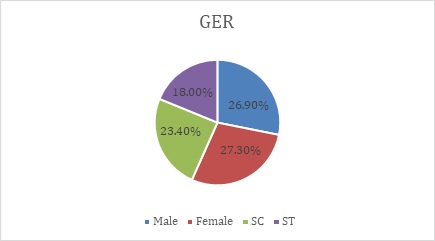
Source AISHE report (2019-2020)
Over a period of time, there is a significant increase in GER which shows the various measures taken by the government are working. Uttar Pradesh comes in top position with the highest student enrolment followed by Maharashtra and Tamil Nadu. There is an increase in GER by 0.8% from 26.3% (2018-19) to 27.1% (2019-2020), according to AISHE’s report.
The share of foreign students in our country has also increased. The highest share of foreign students comes from neighboring countries like:
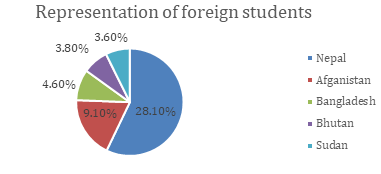
Source AISHE report (2019-2020)
The foreign students come from 168 different countries all over the world. The top 10 countries constitute 63.9% of the total foreign students enrolled in our country.
The total number of teachers in our country stands at 15, 03,156 as per the latest AISHE Report (2019-2020). The ratio of Male teachers to Female teachers is given below:

Source AISHE report (2019-2020)
The data on teachers is also classified according to various social categories such as others which constituted about 56.50%, SC 9%, ST 2.40%, and OBC 32.10%.
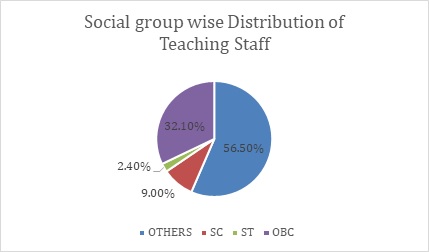
Source AISHE report (2019-2020)
The total enrolment in 2020-2021 from primary to higher secondary level of school education was little over 25.38 Crore. Enrolment for boys was 13.17 crores and that of the girls was 12.21 Crore.
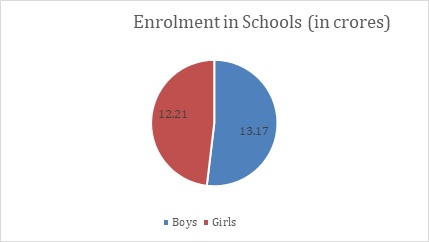
Source UDISE+ report (2020-2021)
The following data shows the percentage of teachers by classes taught. The highest share of teachers was of Primary Only teachers who accounted for 36%.

Source UDISE+ report (2020-2021)
The lowest share of teachers was of Pre-Primary Only teachers who accounted for 1% only. The above data clearly shows the distribution of teachers percentage-wise who are teaching various categories as mentioned above.
Distribution of teachers’ Gender wise. The data clearly shows there is a significant increase in the number of female teachers to the number of male teachers.
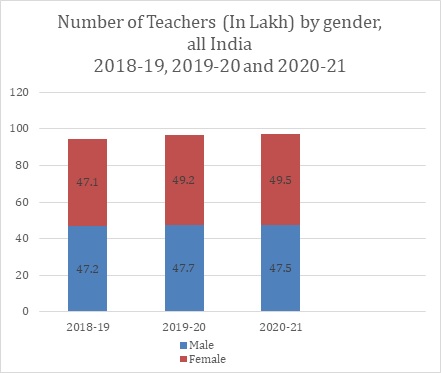
Source UDISE+ report (2020-2021)
After checking the data we can conclude that post-Independence there is a sharp increase in Literacy rate, a reduction in gender disparities, and an increase in enrolment in Education at all levels starting from Pre-primary to Higher Education.

